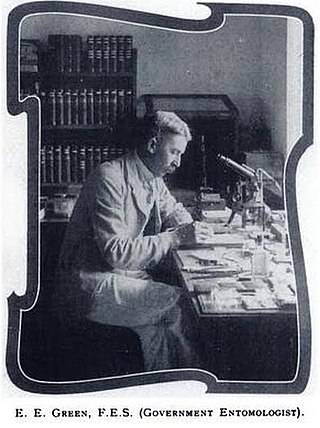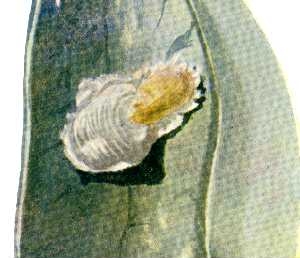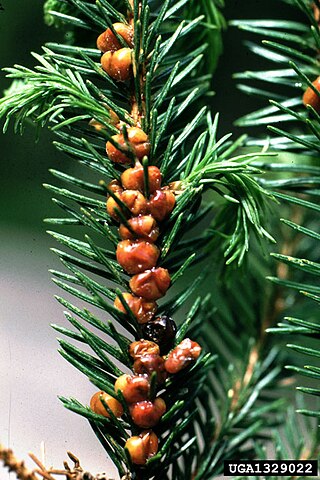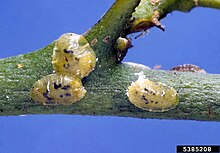
Scale insects are small insects of the order Hemiptera, suborder Sternorrhyncha. Of dramatically variable appearance and extreme sexual dimorphism, they comprise the infraorder Coccomorpha which is considered a more convenient grouping than the superfamily Coccoidea due to taxonomic uncertainties. Adult females typically have soft bodies and no limbs, and are concealed underneath domed scales, extruding quantities of wax for protection. Some species are hermaphroditic, with a combined ovotestis instead of separate ovaries and testes. Males, in the species where they occur, have legs and sometimes wings, and resemble small flies. Scale insects are herbivores, piercing plant tissues with their mouthparts and remaining in one place, feeding on sap. The excess fluid they imbibe is secreted as honeydew on which sooty mold tends to grow. The insects often have a mutualistic relationship with ants, which feed on the honeydew and protect them from predators. There are about 8,000 described species.

The Museum of Zoology and Natural History, best known as La Specola, is an eclectic natural history museum in Florence, central Italy, located next to the Pitti Palace. The name Specola means observatory, a reference to the astronomical observatory founded there in 1790. It now forms part of the Museo di Storia Naturale di Firenze. This museum is part of what are now six different collections at four different sites for the Museo di Storia Naturale di Firenze.

The Chamaemyiidae are a small family of acalyptrate flies with less than 200 species described worldwide. The larvae of these small flies are active and predatory and are often used for biological control of aphids, scale insects, and similar pests. Chamaemyiid fossils are poorly represented in amber deposits, but a few examples are known from the Eocene epoch onwards.

Adolfo Targioni Tozzetti was an Italian entomologist who specialised in Sternorrhyncha. He was Professor of Botany and Zoology in Florence, associated with Museo di Storia Naturale di Firenze where his collection remains today at La Specola. He was especially interested in pest species, mainly mealybugs, scale insects and other pests that attack citrus and peaches. He described many new taxa.

The Margarodidae or ground pearls are a family of scale insects within the superfamily Coccoidea. Members of the family include the Polish cochineal and Armenian cochineal and the original ground pearl genus, Margarodes. Beginning in 1880, a number of distinct subfamilies were recognized, with the giant coccids being the first. Although Maskell proposed a new family, many continued to regard the monophlebids as a mere subfamily for many years, and the Margarodidae classification continued to be polyphyletic through the 20th Century. Since then, taking the advice of Koteja several subfamilies and tribes have been elevated into their own families such as Matsucoccidae and Xylococcidae. The pared-down family of Margarodidae is monophyletic.

Edward Ernest Green was an Ceylon-born English mycologist and entomologist who specialised in the scale-insects, Coccidae. An accomplished artist, and lithographer, he illustrated the five volume Coccidae of Ceylon.

Giovanni Targioni-Tozzetti was an Italian librettist.

Coccus is a genus of scale insects in the family Coccidae. Several species, such as Coccus viridis, a major pest of coffee, are major agricultural pests. The type species is Coccus hesperidumLinnaeus.

Pulvinaria is a scale insect genus in the family Coccidae. The type species is Coccus vitis Linnaeus.
In the 10th edition of Systema Naturae, Carl Linnaeus classified the arthropods, including insects, arachnids and crustaceans, among his class "Insecta". True bugs and thrips were brought together under the name Hemiptera.

Dactylopius is a genus of insect in the superfamily Coccoidea, the scale insects. It is the only genus in the family Dactylopiidae. These insects are known commonly as cochineals, a name that also specifically refers to the best-known species, the cochineal. The cochineal is an insect of economic and historical importance as a main source of the red dye carmine. It has reportedly been used for this purpose in the Americas since the 10th century. Genus Dactylopius is also important because several species have been used as agents of biological pest control, and because several are known as invasive species.

Pulvinaria regalis is a species of scale insect in the family Coccidae. Although it is commonly known as the horse chestnut scale, it affects other trees besides horse chestnuts as well as many species of woody shrubs. Adults are normally all female and produce eggs by parthenogenesis. The insects are thought to have originated in Asia but arrived in Europe in the second half of the twentieth century.
Asterolecanium is a genus of pit scale insects. Asterolecanium is distributed worldwide: species have been found in each of the six biogeographic realms, and nearly all of their respective subregions.

The Reale Museo di Fisica e Storia Naturale was an Italian museum founded on 22 February 1775 in Florence that survived until 1878, when its collections were split up in various Florentine museums.

Pulvinaria psidii, is a species of soft scale insect in the family Coccidae.

Physokermes are a genus of scale insects known as the bud scales. They are restricted to the Holarctic, though Physokermes hemicryphus has been introduced to North America. Some species are plant pests.

Eulecanium is a genus of true bugs belonging to the family Coccidae.

The Myzolecaniinae are a subfamily of scale insects belonging to the family Coccidae. They are commonly known as soft scales, wax scales or tortoise scales. The females are flat with elongated oval bodies and a smooth integument which may be covered with wax. In some genera they possess legs but in others, they do not, and the antennae may be shortened or missing. The males may be winged or wingless.

Toumeyella is a genus of tortoise scales in the subfamily Myzolecaniinae of the true bug family Coccidae.

















